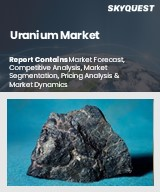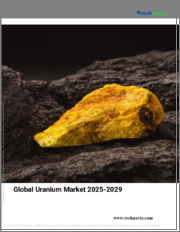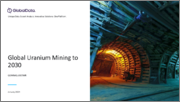
|
시장보고서
상품코드
1755512
우라늄 시장 규모, 점유율, 성장 분석 : 유형별, 용도별, 최종 이용 산업별, 지역별 - 산업 예측(2025-2032년)Uranium Market Size, Share, and Growth Analysis, By Type (Uranium Ore, Processed Uranium (Yellowcake)), By Application (Nuclear Power Generation, Military & Defense), By End-Use Industry, By Region - Industry Forecast 2025-2032 |
||||||
세계의 우라늄 시장 규모는 2023년에 150억 달러로 평가되었고, 예측 기간(2025-2032년) CAGR은 3.8%로, 2024년 155억 7,000만 달러에서 2032년에는 209억 8,000만 달러로 성장할 전망입니다.
우라늄 시장은 원자력 에너지에 대한 전 세계적인 수요 증가, 원자로 기술 및 설계의 발전, 우라늄 분야에 대한 막대한 투자에 힘입어 큰 성장이 예상됩니다. 저탄소 에너지원으로의 전환이 원자력 발전에 대한 관심을 다시 불러일으키고 있으며, 유리한 정부 정책이 뒷받침되고 있습니다. 원자재 펀드, 개인 투자자, Sprott Physical Uranium Trust와 같은 단체의 투자자들의 관심 증가도 시장 동향을 자극하고 있습니다. 그러나 원자력 인프라에 대한 높은 초기 투자비용, 여론의 반대, 재생에너지와의 경쟁, 정치적 민감성 등의 문제는 우라늄의 채택을 방해할 수 있습니다. 전반적으로, 에너지 안보와 전력 인프라의 자급자족이 지속적으로 강화됨에 따라 시장은 확대될 것으로 보입니다.
목차
서론
- 조사 목적
- 조사 범위
- 정의
조사 방법
- 정보 조달
- 2차·1차 데이터 방법
- 시장 규모 예측
- 시장 전제조건과 제한
주요 요약
- 세계 시장 전망
- 공급과 수요 동향 분석
- 부문별 기회 분석
시장 역학과 전망
- 시장 개요
- 시장 규모
- 시장 역학
- 성장 촉진요인과 기회
- 성장 억제요인과 과제
- Porter의 Five Forces 분석
주요 시장 인사이트
- 중요 성공 요인
- 경쟁 정도
- 주요 투자 기회
- 시장 생태계
- 시장의 매력 지수(2024년)
- PESTEL 분석
- 거시경제 지표
- 밸류체인 분석
- 가격 분석
- 규제 상황
- 사례 연구
- 기술 분석
우라늄 시장 규모 : 유형별, CAGR(2025-2032년)
- 시장 개요
- 우라늄 광석
- 가공 우라늄(Yellowcake)
- 육불화 우라늄
우라늄 시장 규모 : 용도별, CAGR(2025-2032년)
- 시장 개요
- 원자력발전
- 군 및 방위
- 의학
우라늄 시장 규모 : 최종 이용 산업별, CAGR(2025-2032년)
- 시장 개요
- 에너지
- 방위
- 헬스케어
우라늄 시장 규모 : 지역별, CAGR(2025-2032년)
- 북미
- 미국
- 캐나다
- 유럽
- 독일
- 스페인
- 프랑스
- 영국
- 이탈리아
- 기타 유럽
- 아시아태평양
- 중국
- 인도
- 일본
- 한국
- 기타 아시아태평양
- 라틴아메리카
- 브라질
- 기타 라틴아메리카
- 중동 및 아프리카
- GCC 국가
- 남아프리카공화국
- 기타 중동 및 아프리카
경쟁 정보
- 주요 5개사 비교
- 주요 기업의 시장 포지셔닝(2024년)
- 주요 시장 기업이 채택한 전략
- 최근 시장 동향
- 기업의 시장 점유율 분석(2024년)
- 주요 기업 개요
- 기업 상세
- 제품 포트폴리오 분석
- 기업 부문별 점유율 분석
- 매출 전년대비 비교(2022-2024년)
주요 기업 개요
- Cameco Corporation(Canada)
- Kazatomprom(Kazakhstan)
- Orano(France)
- Uranium Energy Corp.(U.S.)
- Energy Fuels Inc.(U.S.)
- BHP Group Limited(Australia)
- Rio Tinto Group(U.K./Australia)
- CNNC(China National Nuclear Corporation)(China)
- ARMZ Uranium Holding Co.(Russia)
- Paladin Energy Ltd.(Australia)
- NexGen Energy Ltd.(Canada)
- Denison Mines Corp.(Canada)
- Peninsula Energy Limited(Australia)
- Toro Energy Limited(Australia)
- Berkeley Energia Limited(U.K./Spain)
- Uranium Resources, Inc.(U.S.)
- Forsys Metals Corp.(Canada)
- Energy Resources of Australia Ltd.(Australia)
- Deep Yellow Limited(Australia)
결론과 제안
LSH 25.07.01Global Uranium Market size was valued at USD 15.0 billion in 2023 and is poised to grow from USD 15.57 billion in 2024 to USD 20.98 billion by 2032, growing at a CAGR of 3.8% during the forecast period (2025-2032).
The uranium market is poised for significant growth, driven by rising global demand for nuclear energy, advancements in reactor technology and design, and substantial investments in the uranium sector. The transition to low-carbon energy sources has renewed interest in nuclear power, further supported by favorable government policies. Increased investor interest from commodity funds, retail investors, and entities like the Sprott Physical Uranium Trust is also boosting market dynamics. However, challenges such as high initial investments for nuclear infrastructure, public opposition, competition from renewables, and political sensitivities may hinder uranium adoption. Overall, the market is set for expansion as emphasis on energy security and self-sufficient power infrastructure continues to strengthen.
Top-down and bottom-up approaches were used to estimate and validate the size of the Global Uranium market and to estimate the size of various other dependent submarkets. The research methodology used to estimate the market size includes the following details: The key players in the market were identified through secondary research, and their market shares in the respective regions were determined through primary and secondary research. This entire procedure includes the study of the annual and financial reports of the top market players and extensive interviews for key insights from industry leaders such as CEOs, VPs, directors, and marketing executives. All percentage shares split, and breakdowns were determined using secondary sources and verified through Primary sources. All possible parameters that affect the markets covered in this research study have been accounted for, viewed in extensive detail, verified through primary research, and analyzed to get the final quantitative and qualitative data.
Global Uranium Market Segments Analysis
Global Uranium Market is segmented by Type, Application, End-Use Industry and region. Based on Type, the market is segmented into Uranium Ore, Processed Uranium (Yellowcake) and Uranium Hexafluoride. Based on Application, the market is segmented into Nuclear Power Generation, Military & Defense and Medical. Based on End-Use Industry, the market is segmented into Energy, Defense and Healthcare. Based on region, the market is segmented into North America, Europe, Asia Pacific, Latin America and Middle East & Africa.
Driver of the Global Uranium Market
The global uranium market is being significantly shaped by geopolitical tensions, especially those surrounding major gas exporters such as Russia, which have led nations to emphasize the importance of energy independence. In this context, uranium-based nuclear energy emerges as a reliable domestic alternative to the unpredictable nature of fossil fuel imports. Furthermore, the introduction of supportive government policies aimed at diversifying uranium procurement, establishing long-term contracts, and building strategic reserves is anticipated to bolster the market's prospects significantly through 2032. These factors collectively contribute to a robust outlook for the global uranium industry in the coming years.
Restraints in the Global Uranium Market
The global uranium market is hindered by ongoing public skepticism regarding nuclear energy, stemming from historical incidents such as Chernobyl and Fukushima. The apprehension surrounding radiation, the management of nuclear waste, and the potential for severe accidents contribute to staunch opposition from environmental organizations and local communities. Additionally, political pressures may result in the closure of existing plants or postponements in the approval of new facilities, thereby adversely impacting the demand for uranium. Nations such as Germany and Austria are taking significant steps to phase out nuclear power, highlighting the societal resistance that continues to challenge the industry's growth and stability.
Market Trends of the Global Uranium Market
The global uranium market is witnessing a significant trend towards the demand for Small Modular Reactors (SMRs), driven by substantial investments from countries like the United States, Canada, and the United Kingdom. These compact reactors, which require enriched uranium, create new market opportunities, particularly for uranium companies seeking to optimize sales. The advantages of SMRs, including their smaller footprint and flexibility for deployment in remote areas or as replacements for aging fossil fuel plants, position them as a crucial component in the energy transition. This trend underscores a strategic shift in the uranium sector, aligning with global sustainability and energy security goals.
Table of Contents
Introduction
- Objectives of the Study
- Scope of the Report
- Definitions
Research Methodology
- Information Procurement
- Secondary & Primary Data Methods
- Market Size Estimation
- Market Assumptions & Limitations
Executive Summary
- Global Market Outlook
- Supply & Demand Trend Analysis
- Segmental Opportunity Analysis
Market Dynamics & Outlook
- Market Overview
- Market Size
- Market Dynamics
- Drivers & Opportunities
- Restraints & Challenges
- Porters Analysis
- Competitive rivalry
- Threat of substitute
- Bargaining power of buyers
- Threat of new entrants
- Bargaining power of suppliers
Key Market Insights
- Key Success Factors
- Degree of Competition
- Top Investment Pockets
- Market Ecosystem
- Market Attractiveness Index, 2024
- PESTEL Analysis
- Macro-Economic Indicators
- Value Chain Analysis
- Pricing Analysis
- Regulatory Landscape
- Case Studies
- Technological Analysis
Global Uranium Market Size by Type & CAGR (2025-2032)
- Market Overview
- Uranium Ore
- Processed Uranium (Yellowcake)
- Uranium Hexafluoride
Global Uranium Market Size by Application & CAGR (2025-2032)
- Market Overview
- Nuclear Power Generation
- Military & Defense
- Medical
Global Uranium Market Size by End-Use Industry & CAGR (2025-2032)
- Market Overview
- Energy
- Defense
- Healthcare
Global Uranium Market Size & CAGR (2025-2032)
- North America (Type, Application, End-Use Industry)
- US
- Canada
- Europe (Type, Application, End-Use Industry)
- Germany
- Spain
- France
- UK
- Italy
- Rest of Europe
- Asia Pacific (Type, Application, End-Use Industry)
- China
- India
- Japan
- South Korea
- Rest of Asia-Pacific
- Latin America (Type, Application, End-Use Industry)
- Brazil
- Rest of Latin America
- Middle East & Africa (Type, Application, End-Use Industry)
- GCC Countries
- South Africa
- Rest of Middle East & Africa
Competitive Intelligence
- Top 5 Player Comparison
- Market Positioning of Key Players, 2024
- Strategies Adopted by Key Market Players
- Recent Developments in the Market
- Company Market Share Analysis, 2024
- Company Profiles of All Key Players
- Company Details
- Product Portfolio Analysis
- Company's Segmental Share Analysis
- Revenue Y-O-Y Comparison (2022-2024)
Key Company Profiles
- Cameco Corporation (Canada)
- Company Overview
- Business Segment Overview
- Financial Updates
- Key Developments
- Kazatomprom (Kazakhstan)
- Company Overview
- Business Segment Overview
- Financial Updates
- Key Developments
- Orano (France)
- Company Overview
- Business Segment Overview
- Financial Updates
- Key Developments
- Uranium Energy Corp. (U.S.)
- Company Overview
- Business Segment Overview
- Financial Updates
- Key Developments
- Energy Fuels Inc. (U.S.)
- Company Overview
- Business Segment Overview
- Financial Updates
- Key Developments
- BHP Group Limited (Australia)
- Company Overview
- Business Segment Overview
- Financial Updates
- Key Developments
- Rio Tinto Group (U.K./Australia)
- Company Overview
- Business Segment Overview
- Financial Updates
- Key Developments
- CNNC (China National Nuclear Corporation) (China)
- Company Overview
- Business Segment Overview
- Financial Updates
- Key Developments
- ARMZ Uranium Holding Co. (Russia)
- Company Overview
- Business Segment Overview
- Financial Updates
- Key Developments
- Paladin Energy Ltd. (Australia)
- Company Overview
- Business Segment Overview
- Financial Updates
- Key Developments
- NexGen Energy Ltd. (Canada)
- Company Overview
- Business Segment Overview
- Financial Updates
- Key Developments
- Denison Mines Corp. (Canada)
- Company Overview
- Business Segment Overview
- Financial Updates
- Key Developments
- Peninsula Energy Limited (Australia)
- Company Overview
- Business Segment Overview
- Financial Updates
- Key Developments
- Toro Energy Limited (Australia
- Company Overview
- Business Segment Overview
- Financial Updates
- Key Developments
- Berkeley Energia Limited (U.K./Spain)
- Company Overview
- Business Segment Overview
- Financial Updates
- Key Developments
- Uranium Resources, Inc. (U.S.)
- Company Overview
- Business Segment Overview
- Financial Updates
- Key Developments
- Forsys Metals Corp. (Canada)
- Company Overview
- Business Segment Overview
- Financial Updates
- Key Developments
- Energy Resources of Australia Ltd. (Australia)
- Company Overview
- Business Segment Overview
- Financial Updates
- Key Developments
- Deep Yellow Limited (Australia)
- Company Overview
- Business Segment Overview
- Financial Updates
- Key Developments
















